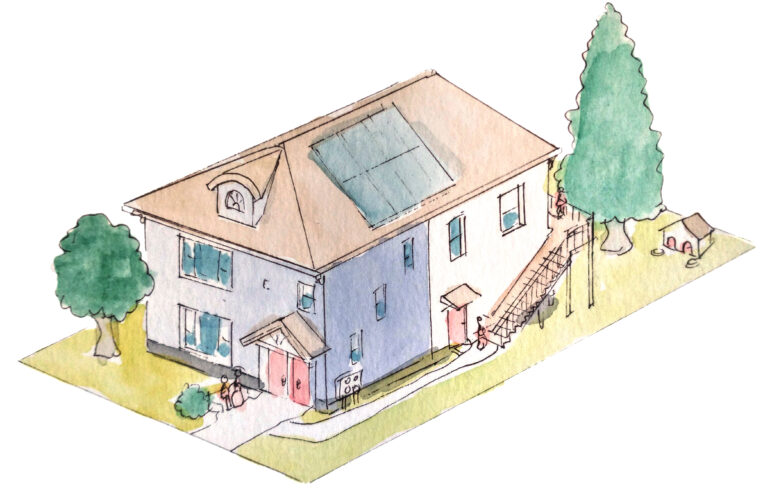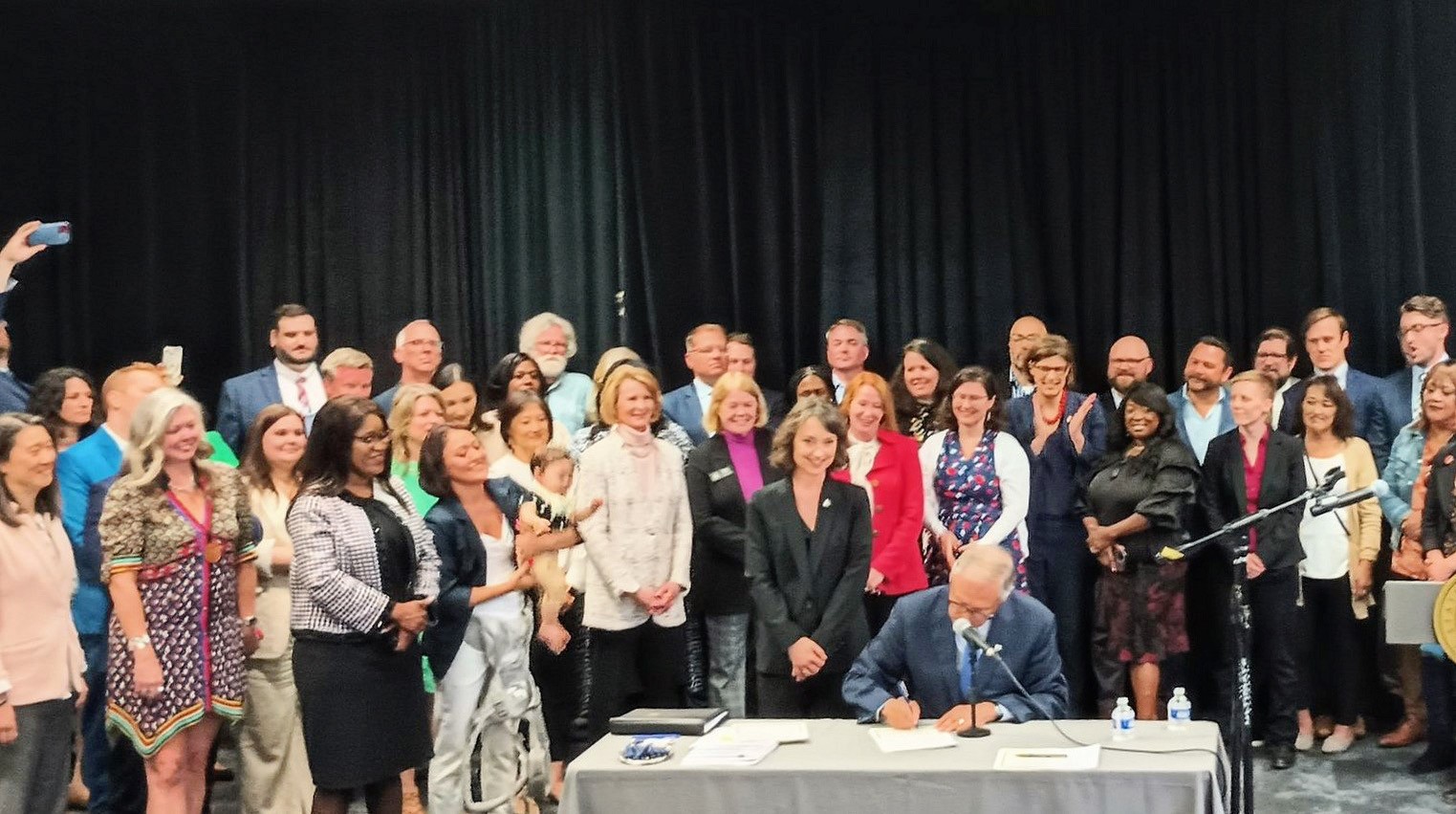Find audio versions of Sightline articles on any of your favorite podcast platforms, including Spotify, Google, and Apple.
Washingtonians just won big on housing abundance. In a landmark session, lawmakers passed a suite of bills to create more home choices, at more affordable prices, in communities all across the state. These measures, large and small, get at the core problem: the acute shortage of homes that has blown up prices and rents and caused a statewide affordability crisis. To make it official, Governor Inslee will sign the bills at a ceremony today in Seattle.
Thanks to these new laws, over the decades ahead, tens or even hundreds of thousands of people will be able to live in more walkable, lower-carbon neighborhoods, in homes they can afford, close to opportunity, close to jobs, schools, transit, and parks—close to each other. Washington just took a big step away from sprawl and segregation and toward compact communities that welcome more neighbors of all ages, races, ethnicities, and incomes, where cars are an accessory to life and not its organizing principle.
The biggest win for housing abundance in Washington’s cities is HB 1110, which legalizes fourplexes or duplexes in most communities. Close behind is HB 1337, legalizing two accessory dwelling units per lot and lifting numerous restrictions.
On top of those two biggies, bills passed that:
- legalize adding housing to existing buildings,
- develop building code for single-stair apartments,
- prevent abuse of environmental review that blocks housing,
- help cities streamline permitting,
- put guardrails on onerous local design review, and
- reduce regulatory barriers to condo construction.
Below we describe how we got here and what these measures’ impact could be. Then we discuss each bill in detail.
How 2023 became the “year of housing”: Coalitions, champions, and greater public understanding
It’s no small task to pass state bills that defy typical local zoning, the rules that have for nearly a century codified the “American dream” of a big house with a lawn and driveway. Up until this year, only Oregon and California had pulled it off. Washington can now join that elite club. Montana, of all places, earned membership this year, too. And Colorado currently has a strong bill in play. Meanwhile, statewide zoning reform has stalled in New York and Arizona.
In the previous four years Washington only managed to pass a few narrow bills, no matter the good efforts of a handful of pro-housing legislators. This year, the dam finally burst under compounding pressure from multiple factors:
- More constituents seeing or personally experiencing the worsening crises of housing affordability and homelessness;
- Increasing consensus that the core problem is a housing shortage and that restrictive zoning is the main culprit;
- Superhero champions, notably Rep. Jessica Bateman on the middle housing bill and Rep. Mia Gregerson on the ADU bill;
- Bipartisanship: All of the above-named bills passed with strong bipartisan votes and could have died without Republican support, notably led by Rep. Andrew Barkis (Republican opposition was a big factor in the recent failure of New York’s big housing bill, for example);
- A pro-housing coalition that was stronger and broader than ever before (see for example this coalition letter organized by Senator Yasmin Trudeau and Lt. Governor Denny Heck); and
- Last but not least, the legislature’s always capricious swirl of internal process and politics.
Impact of housing abundance wins: Helping to close the homebuilding gap
Washington’s housing abundance wins couldn’t come soon enough. Over the past few decades the state has dug itself into a deeper and deeper hole on housing, and it will take all these actions and more to get out of it. By one estimate, the deficit rose from 64,000 homes in 2012 to 140,000 in 2019.
Officials project that Washington needs to add an average of 55,000 more homes per year over the next 20 years. In recent years, the state has been permitting around 45,000 homes per year, give or take. So if the status quo continued, the state still would fall behind by roughly 10,000 homes per year.
The lack of precedent for statewide zoning reforms makes homebuilding projections difficult. Best available data suggest that the middle housing and ADU bills together could make up for at least half of the 10,000-home-per-year gap between what Washington has been building and what it needs to build (more on projections below). The boost in homebuilding that could result from the measures that reform building codes and accelerate permitting is even harder to estimate. But in a housing crisis, every bit helps.
All told, the package of bills that Washington passed this year is a monumental leap toward alleviating the state’s housing shortage and creating more homes that more people can afford, in neighborhoods where they can thrive.
That said, this year’s wins won’t be sufficient. State lawmakers have more work to do next year. The top three policy candidates would be legalizing apartment buildings near transit, lifting parking mandates, and allowing homeowners to split their lots.
Read on for a closer look at the 2023 bills.

The housing abundance bills that passed in 2023, explained
Saying yes to middle housing
On the passage of HB 1110, I wrote that it’s “hard to overstate what a sea change this is for the state of Washington taking proactive action on zoning reform to create more housing choices.” State lawmakers have never before come anywhere close to passing a law with such a dramatic effect on local zoning. On the vast majority of residential lots all across Washington, cities will no longer be able to restrict choice to a single-detached house. The most pervasive and harmful form of exclusionary zoning is a thing of the past.
Most local government officials oppose bills that supersede local control of zoning, and in the prior four legislative sessions the Association of Washington Cities (AWC) effectively led the charge to water down or kill any and all mandatory zoning reform bills. This year, however, the pressure for statewide action became too great. AWC and legislators aligned with the group prevailed on a few compromises that weakened HB 1110, but overall the bill remained strong.
The upshot of what HB 1110 does (more here):
- In cities with populations of 75,000 more, it legalizes four homes per residential lot, and six per lot if located within a quarter-mile of a major transit stop or if two of the homes are affordable.
- In cities with populations greater than 25,000 but less than 75,000, it legalizes two homes per lot, and four per lot if located within a quarter-mile of a major transit stop or if one of the homes is affordable.
- In cities with populations under 25,000 that are located within the state’s largest metros, it legalizes two homes per lot.*
- Alternatively, cities can comply by authorizing the above allowances on three-quarters of their residential lots, subject to limitations on the parcels included or excluded.**
- Cities must adopt zoning that complies with the bill within six months of completing their next Comprehensive Plan update. That means mid-2025 for cities in the four-county Puget Sound region, and in following years for other parts of the state.
The version of HB 1110 that passed was weakened from the original in three significant ways:
- The Senate Ways & Means committee reduced the requirement from four homes to two homes for cities smaller than 75,000. The bill as it passed the House would have legalized fourplexes in any size city located in a major metro.*
- On the floor, the House amended the alternative compliance path to 75 percent of lots, as noted above.
- The House Housing committee raised the cap on parking mandates from one space per lot to one space per housing unit.
For comparison, Oregon’s 2019 middle housing bill legalized four homes per lot in cities larger than 25,000 located in the Portland metro; and it legalized two homes per lot in all remaining cities in the Portland metro, and in all cities larger than 10,000 statewide. California’s 2021 bill SB 9 legalized duplexes and lot splitting for all residential lots statewide that are located in an urbanized area or urban cluster as designated by the US Census.
Officials estimated that HB 1110 will yield an additional 75,000 to 150,000 homes over the next 20 to 30 years in the Puget Sound region, which is home to about two-thirds of the state’s population. Scaled up on a per capita basis for the entire state, the midpoint of that estimate is an average of 6,700 homes per year statewide.
The uptake on home construction legalized by HB 1110 will depend on the details of how local governments implement the zoning changes. If, for example, cities require too much parking or don’t allow multiple-unit buildings to be larger than single-unit houses, uptake will suffer.
Saying yes to in-law apartments and backyard cottages
Washington’s passage of HB 1337 puts it at the top of the heap for the best statewide accessory dwelling units (ADU) policies in the US (they’re also known as “backyard cottages” and “bonus homes”).
Compared with Washington, California went further on reducing parking mandates but not as far on design standards such as size and height. Oregon took the critical step of completely eliminating parking mandates but was mostly mute on design standards. Montana’s legislature just passed a strong bill that ends parking mandates and lifts all the key barriers but only legalizes one ADU per lot.
Here’s what HB 1337 does (fun fact: it’s nearly identical to the ADU bill Rep. Gregerson first primed in 2019):
- Prohibits owner occupancy requirements (also known as “renter bans”);
- Legalizes two ADUs per lot in any configuration of attached and detached options;
- Caps impact fees at 50 percent of those charged on single-detached houses;
- Lifts parking mandates on ADUs within a half-mile of a transit stop with 15-minute service; otherwise caps mandates at one space per ADU on lots under 6,000 square feet;
- Legalizes an ADU on any lot size that’s legal for a single-detached house;
- Establishes that cities allow a minimum size of at least 1,000 square feet; and
- Loosens several other restrictions (see details here).
Though it morphed along the way, HB 1337 as passed was overall about as strong as it was when introduced. The original version gave cities flexibility to choose three out of the first four actions in the list above, except that the parking provision completely lifted mandates. The Senate Local Government Committee removed the parking provision but mandated the remaining three actions. Then on the floor, the Senate amended in the parking reductions noted above.
The House pushed out the compliance date from July 2024 to six months after the jurisdiction’s next Comprehensive Plan update. Unfortunately, that’s an added delay of about a year for most of the Puget Sound region and several years of delay in other parts of the state.
The best we can do for a production estimate is a back-of-the-envelope figure based on data from other places that have already adopted similar ADU rules. ADU completions in California increased by about 10,000 per year after all its reforms were adopted. Scaling by relative population, we could expect an average boost of about 2,000 ADUs per year in Washington. As an upper bound, if all of Washington’s urban growth areas saw a per capita increase in ADU production similar to Seattle’s post-ADU-reform boost, that would be about 5,000 ADUs per year.
Saying yes to better building codes
HB 1042 facilitates adding housing within the envelope of existing multifamily buildings by exempting the added units from parking mandates, density limits, and other regulatory barriers. It enables a commonsense solution for creating more homes relatively quickly and with minimal impact on the surrounding community.
SB 5491 requires the State Building Code Council to develop recommendations for raising the allowed height of apartment buildings with a single stairway to six stories and to adopt those changes by 2026. Single-stair buildings fit well on small urban infill lots and also allow for better light and ventilation because each apartment has an exterior wall on the front and back.
SB 5258 modifies condo laws on construction defect actions and warranties, deposit requirements, and local government planning, and would exempt condo sales to first-time homebuyers from the real estate excise tax. For years, Washington has suffered from a dearth of condo construction, which has worsened the state’s shortage of lower-cost homeownership options.
SB 5058 exempts projects of two stories, with up to 12 units, from building enclosure design and enclosure inspection requirements, both of which add excessive costs to small-scale condo developments.
Saying yes to streamlined permitting
HB 5412 exempts from State Environmental Policy Act (SEPA) review proposed housing developments within urban growth areas that comply with local Comprehensive Plans. SEPA review has become largely redundant with local regulations and adds cost and delay to homebuilding. Worse, it makes it easy for activists to abuse SEPA to block housing through legal appeals.
HB 1293 requires local design review of homebuilding projects to use standards that are “clear and objective” and don’t reduce development capacity. In addition, the review process cannot require more than one public meeting. Capricious design review requirements can drive up the cost of homebuilding by adding delay and uncertainty.
SB 5290 establishes grant programs for local governments to reduce permit review timelines and supports their transition from paper-based to software/web-based systems. Sightline analysis showed that for a typical six-story apartment building, every two months of delay adds development expense roughly equal to the cost of constructing one apartment.
Saying yes to infill housing abundance as a climate strategy
HB 1181 makes a broad set of changes to the Growth Management Act to address climate change, including a provision for local governments to legalize higher-density housing as a way to meet goals for reducing climate pollution.
Saying yes to record-setting state funding for affordable housing
Washington’s 2023–25 Capital Budget allocates $570 million for affordable housing, including:
- $400 million to the Housing Trust Fund (the highest amount ever),
- $60 million to connect affordable housing developments to infrastructure,
- $50 million for affordable transit-oriented housing, and
- $40 million for land acquisition.
Three bills the Washington legislature should prioritize in 2024
The following three housing abundance measures died in session but fostered important conversations that will surely come up again next year. They’re strong policies that address several remaining key barriers to abundant housing and could unlock thousands more homes per year.
HB 1245 would have legalized lot splitting, allowing homeowners to sell off part of their house lot for the construction of another house, creating more affordable homeownership choices while also providing financial options for existing owners.
SB 5466 would have legalized more homes and jobs near the state’s biggest transit investments. As introduced, it required cities to allow midsize apartment buildings within three-quarters of a mile from bus stops with frequent service, and larger buildings within a quarter-mile of light rail stations.
HB 1351 would have made parking optional near transit by lifting local mandates for off-street parking in new housing or commercial developments located within a half-mile of transit stops with 15-minute service, and within a quarter-mile of stops with 30-minute service.
*Definition: Contiguous Urban Growth Boundary
HB 1110 was designed to exclude small cities in rural areas and include small cities located within the state’s major metros. The bill applies to all cities, regardless of size, that are (1) part of a contiguous urban growth area that includes the largest city in its county, and (2) in a county with a population of least 275,000.
HB 1110 as introduced legalized four homes per lot in cities that met the two above criteria. HB 1110 as passed only legalizes two homes per lot in those cities.
This map shows Washington’s urban growth areas as designated in accordance with the Growth Management Act. Washington has six counties with populations of 275,000 or more.
**Definition: Seventy-five percent compliance path
HB 1110’s alternative compliance path that allows cities to apply the bill’s density requirements to 75 percent of residential lots includes guardrails to ensure that local choices on which areas to exclude do not compromise equitable outcomes:
- The excluded 25 percent must include all environmentally critical areas, and all areas delaying the bill’s implementation based on displacement risk or lack of infrastructure.
- The excluded 25 percent may not include any areas that historically had exclusionary covenants or where retention of existing zoning would exacerbate racially disparate impacts.



Comments are closed.